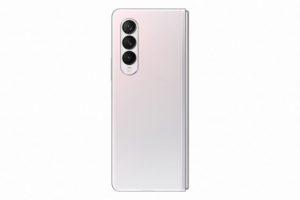
Samsung has officially unveiled its latest flagship smartphone, and cemented under-display camera technology as the major new trend in mobile tech.
The Galaxy Z Fold 3 is the latest in Samsung’s line of foldable phones, which started out with the original, groundbreaking Galaxy Z Fold device in 2019 and continued with a sequel as well as Samsung’s line of Galaxy Z Flip devices. The latest offering features a stronger aluminum frame, a protective film for its foldable screen, and a compatible S-Pen stylus that was specifically designed to ensure it would not damage the foldable display. It also has an IPX8 rating, testifying that it can survive a brief dunk underwater.
In comparison to its predecessor, the battery has been downgraded somewhat, from 4,500 mAh to 4,400 mAh. But so has the price, which has come down from a whopping $2,000 to a whopping $1,800.
Under-display, On the Rise
Beyond these somewhat incremental changes, perhaps the biggest new feature of Samsung’s new foldable device is its under-display camera. Samsung has joined the vanguard in this area, with only a couple of major brands offering their own rival versions of under-display camera technology.
ZTE was first to market last year with its Axon 20 5G smartphone, and this week brought Xiaomi’s Mi Mix 4. OPPO, meanwhile, has made a splashy announcement about its own under-display camera technology, but hasn’t yet revealed a smartphone in which it will be implemented.
The technology’s realization is an important development with respect to mobile biometrics. In the wake of the fingerprint scanning revolution catalyzed by Apple’s launch of Touch ID in 2013, smartphone makers have looked for ways to increase screen size while reducing bezels, and struggled with the need to retain the sensors that enable biometric authentication. The emergence of in-display fingerprint scanning in recent years has allowed many brands to do away with the physical buttons that used to enable fingerprint scanning, but many have still retained notches jutting into the screen to make room for cameras and other sensors.
Now, at a time when selfie-based authentication is more popular than ever, bringing the camera under the screen means retaining the ‘face unlock’ capability while maxing out display space.
‘Just Plain Awful’
The problem is that this technology is still in its early stages, and it isn’t perfect. The Samsung Galaxy Z Fold 3’s under-display solution is a mere 4MP camera, and there has been some early commentary concerning its distortion of the display. A SamMobile report notes that the camera is “more or less noticeable” depending on the viewing angle and the display’s brightness. Commentary from 9to5Google’s Ben Schoon is less kind, calling the camera “just plain awful”, in part because Samsung has attempt to conceal it behind an “obvious octagon of pixels that don’t fit in with the rest of the display.”
The reception suggests that the next phase of this tech arms race will focus on refining, and not merely realizing, the technology. OPPO, for its part, appears to be aware of this. Despite not having an actual product ready to ship, the company’s announcement of its own under-display camera tech focused on the maintenance of clarity in the overlying display, and the sharpness of the selfie camera’s images – thanks to the help of AI-driven adjustments.
To be fair to Samsung, the Galaxy Z Fold 3, by virtue of its foldable nature, is able to feature another, better 10MP selfie camera on the front cover of the device. (There is also a triple-camera rear-facing imaging system.) So it seems that Samsung’s leadership made the calculation that it was better to be one of the first to market with innovative under-camera display technology even if it was more of an innovative gimmick than a fully functional selfie camera that could stand on its own.
In any case, with under-display camera tech now a major trend, and Samsung’s arch rival Apple apparently exploring the technology (as evidenced by IP filings), it seems clear that further innovation in this area will probably be a priority for a number of major smartphone brands.
Sources: TechCrunch, 9to5Google, SamMobile, Samsung

Follow Us